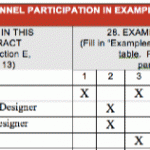
Over the last year, particularly on federal contracts, I’ve been seeing the rise of a very disturbing procurement process. It’s “Brooks Act” compatible. It is a safe method for procurement professionals to use. And it actually puts the incumbent at a disadvantage. What is it?
It is called Lowest Price Technically Acceptable (LPTA for short).
Wait a minute, hasn’t this been around forever? Yes, it has. But, based on what I’m seeing, reading and hearing, the use of this procurement method has dramatically increased since 2013. And it’s now being used to procure everything from construction management, design, consulting, and even training services.
What Is The Lowest Price Technically Acceptable Process?
Here’s how this works (at least from what I’ve seen and been told). The buyer/procurement team identifies technical and qualification requirements that the proposers must meet. For example, they might ask for a project manager with a degree in civil engineering and 10 years experience managing federal construction projects.
Then it provides a scope and asks for a price.
Once you submit your proposal, it goes to a procurement officer. The procurement officer sends the lowest priced proposal to the decision maker(s). The decision maker(s) determines whether that proposal meets the technical and qualification requirements.
If it does, the contract is awarded. If it doesn’t, the decision maker(s) will receive the next lowest priced proposal. Rinse and repeat.
But here’s the kicker. After you win one of these procurements, your price will be communicated to everyone who proposed. And it is possible that you will never be told when your pricing was sent out or who it was sent to.
Therefore, when the contract is reprocured, the incumbent is at a direct disadvantage. Everybody knows their price. But they do not know who proposed on the previous contract and what the losing proposers’ pricing was. Nor do you know how many other firms met the technical requirements.
It would be basically insane for the incumbent to use the same pricing the next time around, since every single competitor knows it. So, the only strategy I know of is to price even lower and hope that you can again “out price” your competitors.
The Basic Flaw With That
Here’s the problem with that strategy. Let’s say you had the contract for three years. The people who worked on it, the people who meet the technical requirements, now cost you more. Theoretically, they did a good job and you gave them raises.
Now, you will have to pay more for them while charging less to the client. I’m no math or economics expert, but that just doesn’t seem like it’s sustainable for the incumbent.
Another Challenge With The Lowest Price Technically Acceptable Process
A key component of the success for any LPTA process is the correct identification of technical criteria. I have to imagine this can be a challenge.
For example, let’s say I’m using this method to procure a brain surgeon to perform surgery on me. What do I know about brain surgery? Nothing. I don’t know what separates a good brain surgeon from an incompetent brain surgeon. So, I have to pull technical criteria out of the air and hope (pray) that I got it right.
Think for a minute about how tough this is. I can require that the brain surgeon have a medical degree, spend 2 years studying under a brain surgeon, and have performed 10 similar brain surgeries. But think about it, the absolute worst brain surgeon in the world probably meets those criteria, right!?! If you don’t know what separates a good brain surgeon from a bad one, it’s essentially a shot in the dark coming up with technical criteria.
Why In The World Would Anyone Use That Procurement Method?
There are two scenarios where Lowest Price Technically Acceptable procurements make a lot of sense.
- Reducing the prices the government pays for services.
- Covering the procurement official’s butt.
What I think people who submit proposals sometimes don’t fully appreciate is that procurement officials who break the rules can be charged with a crime, like this guy or this lady. So, their decisions are often based on their interpretation of, sometimes nebulous, procurement laws and their tolerance for personal risk.
LPTA procurements are great for people who have no tolerance for personal risk because it takes all the qualitative factors out of the decision process. In a way, it takes all the judgment out of the decision. It’s also transparent because you provide everybody who proposed with the final price.
The Lowest Price Technically Acceptable Debate
In January of this year, David Cox, the president of the American Federation of Government Employees defended its use in Government Executive Magazine. He said, among other things, that contractors hate this process because it reduced their profits. That their “bowls of caviar are not quite as full.” He described it as part of the Pentagon’s “war on profits” and explained there is nothing wrong with trying to get the best price for tax payers.
You can imagine the responses to this. Eric Crusius, of Fed Nexus Law shared an opposing view stating that LPTA procurements have severe limitations, are often used when it shouldn’t be, and end up costing the government more. He said the LPTA is “simply a road leading to mediocrity.”
Then in March, the Department of Defense sent out a memo warning of the overuse of LPTA. So, at this point, it seems even the Feds are recognizing that LPTA’s use has exploded.
How This Affects You
Even if you don’t work in the federal market, rest assured that what happens in the federal market often finds a way to trickle down to the state and even local level. Just ask yourself whether you’ve filled out any SF330s for state and local agencies.
If you liked this article, please subscribe below or on the right side of the homepage. If you want to give us your thoughts on this issue, please leave a comment below.





Thanks for a great article, Matt.
I understand that a client might consider this LPTA selection method because he/she believes that it gives them a lower overall cost for the contract. But following your reasoning, the incumbent cannot afford to resubmit for the next contract, so the selection process ends up being both ineffective and inefficient — the client always winds up selecting a firm that knows little or nothing about how they like to work, what kind of communication they like to receive, what kind of documentation they prefer with the consultant’s invoices, and other issues.
It’s unfortunate, but I believe it’s going to take a couple of dramatic accidents before owners realize that selecting the firm that meets the minimum technical requirements is not the same as selecting the best qualified firm.
Thanks for the comment.
Before starting this contribution, I should explain that I’m a UK based bid consultant who helps small to medium companies win tenders. With 16 years’ experience, handling proposals up to a quarter of a billion sterling, and with a better than 80% win rate, I’ve seen a few things in my time.
So here’s my considered, professional input on this: LPTA is a disaster for virtually all procurements (apart from the simplest commodities).
Sadly, since the crash of 2008, LPTA has become a trend here in the UK for service contracts to the public sector as well. But, strangely, LPTA is actually a recipe for MORE cost.
Here’s what happens.
The organisation procures the cheapest service, then the procurement department smiles and signs the contract. The hapless users are left holding the baby.
Next, the operational staff find that the service or goods purchased really do not meet the quality they need. So staff refuse to use the service or goods, or muddle through as best they can.
Contract management overheads soar as middle managers get involved. Unions complain, on behalf of their suffering members. Operations suffer: the public notices and complains. This also adds to management overheads. Getting no joy, the public go to their Members of Parliament. The Press finds out and starts hounding the public sector organisation; the MP investigates; and suddenly senior management are sucked into the emerging black hole of time, stress, energy and costs. The contract fails and the public sector body ends up having to reprocure.
Sound unusual? Not really. I advised a client recently on a health sector procurement that was 90% on price. (Really, it was LPTA – the health authority allocated 10% of “quality” to the ability of bidders to provide resources – which was a joke and virtually nothing to do with real service quality for the hapless public.) I went through a highly detailed cost analysis for my client and this enabled them to submit an extremely tightly priced tender. Our analysis told us we could upsell once in contract, so we took a risk and went in (with our eyes open).
They still lost the contract to somebody who bid a crazily low price.
But that wasn’t the end of the matter. After the dust settled, the awarding Authority went to chat to the preferred bidder. Lo and behold, it turned out the low-ball merchants could not actually meet all the requirements at that price after all. (Duh.) So they withdrew.
Guess what: the Public Sector body had to come back to my client and procured the much higher quality service for a larger price. After wasting time, effort and money on the LPTA procurement…. good news for my client, bad news for public sector costs.
Here’s something that the enlightened procurement professionals are starting to realise:
“It’s unwise to pay too much, but it’s worse to pay too little. When you pay too much, you lose a little money, that is all. When you pay too little you sometimes lose everything, because the thing you bought was incapable of doing the thing it was bought to do.” – John Rustin, 1819-1900
Thanks.
Matt,
Great article. These challenges are not exclusive to the formal LPTA process, in fact we’ve often seen the so-called “best-value” selection process devolve into LPTA once the contracting officer deems all or most of respondents to be “equally qualified”. I see this as a symptom of the larger malaise affecting the A/E/C industry, which is that most firms do a lousy job differentiating ourselves in a way that is meaningful to the client. If we all describe our firms in the same terms, all claim to be “uniquely qualified”, and offer similar experience and qualifications in our submittals, is the client to blame when they can’t tell firms apart, or are we?
I think it’s also worth highlighting that the power of the contracting officer doesn’t end with the selection process. Past performance reports, a critical piece of source selection data, are also written by the contracting officer–not the client agency’s technical lead or project manager who really understands what happened on the job and what the firm did or did not do well. Firms must take advantage of their opportunity (typically a 30-day window within CPARS) to review past performance reports as they are submitted, and make an effort to ensure that credit for better than “satisfactory” performance is given when due. That is much easier to accomplish when one has a strong advocate or champion within the client agency; which is to say that basic client relationship management is more important than ever, even in the federal sector.
Good summary and viewpoint, Matt. This is scary for the A/E/C industry, but it does prove the need for differentiation because with it, a firm could potentially disqualify every competitor.
Thank you for the comment.